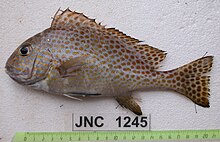| Diagramma | |
|---|---|
 | |
| Diagramma pictum | |
| Scientific classification | |
| Domain: | Eukaryota |
| Kingdom: | Animalia |
| Phylum: | Chordata |
| Class: | Actinopterygii |
| Order: | Acanthuriformes |
| Family: | Haemulidae |
| Subfamily: | Plectorhinchinae |
| Genus: | Diagramma Oken, 1817 |
| Type species | |
| Anthias diagramma | |
| Synonyms [1] | |
Spilotichthys Fowler, 1904 | |
Diagramma is a genus of marine ray-finned fishes belonging to the family Haemulidae, grunts native to the Indian Ocean and the western Pacific Ocean. [2]